Bored Kid? The Best 50 Activities That Will Keep Kids Busy + Happy
One hour into a full day at home with your kids, and they’re bouncing around the house like Tigger, scattering toys across the floor of every room in the house, and interrupting you every 7.2 minutes to ask for a snack.
If you work from home, need to catch up on household chores, or just need a break from being “on” for your kids all the time, 12 hours a day can feel like a lot of hours to figure out how to keep kids busy and entertained.
And so understandably, you find yourself always on the lookout for activities for kids at home. Fun activities that might even be a little educational to boot. And maybe, just maybe, one day you’ll find the perfect list of activities that will keep your child from wasting the day away on video games – or on watching videos of other kids playing video games.
Bonus: As a bonus for joining my weekly newsletter, get this free printable of the best 50 activities for kids at home that will actually keep your child busy and happy.
3 Essential Ingredients You Need to Keep Your Child Busy + Engaged
This list of activities for kids is different than some others you might find. Because this isn’t about having 20 gabazillion activities listed in one place. This isn’t about buying a bunch of special supplies or materials your child will use once and never touch again. And this isn’t about the activities that make the prettiest pictures so they earn likes on Instagram.
This list of activities for kids at home is about what works.
In other words, the activities listed later in this post will actually keep kids engaged so that your child doesn’t lose interest after a few minutes and announce, “I’m borrrrrred.”
First, here’s a quick run-down of three essential ingredients when it comes to activities that keep your child busy and engaged. The activities in this post take care of the first two factors for you, and you’ll find a bonus section at the end of this post to help you with the last factor.
- Independent – Can a child engage in this activity independently, or does it require a parent to supervise or participate? Sometimes it’s fine for an activity to require parental involvement, but other times you might need activities your kids can do independently so you can get something important done yourself. And so this post focuses on activities your child can do independently.
- Engaging – Will this activity captivate a child’s attention, or will they get bored and lose interest quickly? Many child development experts divide toys and activities into two categories: open-ended and single-action (or closed). An open-ended activity might be to set up a basket of various art supplies and materials for your child to explore, whereas a single-action activity would be to print one coloring page for your child. Your child can explore the art basket and be creative in how they choose to engage with the materials, but with the coloring page, your child has only one way to engage with it: color the picture already drawn for them. The toys and activities that deliver the highest quality play for kids – meaning they show sustained interest and are active and absorbed in the play – tend to be open-ended. There’s nothing wrong with single-action toys and activities, but on the whole, they’re nowhere near as effective at keeping kids engaged. On the other hand, open-ended activities are more likely to spark your child’s creativity, captivate their attention, and actually nurture your child’s skills like problem-solving. Which is why this post focuses on open-ended activities.
- Hidden causes of boredom – If your child gets bored easily and can’t seem to stay engaged in any activity for very long, a handful of underlying factors might be interfering with your child’s ability to get “lost” in an activity and stay engaged. But the good news is you can do a quick check of these factors and eliminate any roadblocks to your child’s ability to play independently. If your child struggles with this, check out the 4 Hidden Reasons Why Your Kid Gets Bored Easily section later in this post for how to address the most common underlying issues.

The Best 50 Activities for Kids At Home
Whether you find yourself at home with your kids during a bad weather day, a teacher in-service training day, or an extended school break where you’re also trying to work from home, this list of fun activities for kids at home is for you. This list will help you keep your child busy and happily engaged – and likely even learning something too.
But first, you need to know a couple important differences when it comes to this list of activities for kids:
- For the times when you need activities your kids can do independently so you can get something important done yourself, you’ll find those activities marked with a star like this . A star like this indicates the activities that could be independent, depending on your child’s age and temperament or if you have more than one child.
- The activities in this list skew more heavily towards open-ended because those types of activities are more likely to keep your child actively engaged, learning, and thinking deeply.
Pro tip: Some families like to set up clear plastic bins to keep each activity separate so they’re easy to pull out and have ready to go. The benefit of setting up these “Choose Your Own Adventure” bins is that if your child gets bored with whatever activity they selected, they can easily put that one away and see what’s in the other bins to pick what they want to get out next. (By the way, we’ve tried several brands, and these clear bins have stood up best over time.)
Related: Working From Home With Kids? Here’s the Best Advice for Parents {Printable}
Before You Forget…
At the end of the post, don’t forget to get the handy free printable list of all these activities for kids at home.
Here’s a sneak peek of your free printable:
Note: In the list below, indicates activities that kids can typically do independently without needing parental involvement beyond a quick initial setup and explanation. indicates the activities that could be independent, depending on your child’s age and temperament or if you have more than one child.
Creative Fun
The process of open-ended creating helps kids relax, focus, feel successful, and learn to express their emotions.
If you need activities for kids at home that will keep them engaged for longer, try these creative options:
- Bust out the play dough or slime. Don’t have any? Make some, then let your kiddo loose with some fun play dough tools like this. (If my zero-craftiness self can make homemade dough, you totally can!)
- Solve a jigsaw puzzle. About once a week, my kids will go on a puzzle binge, putting together puzzle after puzzle. Our favorite puzzles for younger kids are the Melissa & Doug floor puzzles. For older kids, the Ravensburger puzzles are high-quality and have lots of fun options to choose from.
- Play a board game or card game. If you have more than one child, they can play together. If you have an only child, you can teach them solitaire games they can play independently. If the games you have aren’t keeping your child engaged, check out this list of the best board games for all ages.
- Listen to a podcast for kids. Some of our favorites are Brains On, But Why, Stories Podcast, Tumble, and Wow in the World. For tweens and teens, we also enjoy Book Club for Kids, Stuff You Should Know, and This American Life.
- Build an epic fort. Set your child up with the supplies they need, such as sheets, tablecloths, or curtains; command hooks and string to attach blankets to the wall; and pillows, blankets, or rugs to make it cozy. Then when it’s done, they can show it off to you!
- Make a craft. Get your child everything they need to make something fun like friendship bracelets, a latch hook project, a cross-stitch design, and so on.
- Play pretend with paper dolls. This isn’t just for girls! My son loves playing pretend with paper dolls just as much as his sisters do. We got these adorable handmade color-in paper dolls you can print at home, which kept my kids busy while they colored them in, cut them, and then dressed up the dolls. For younger kids, the magnetic dress-up sets from Melissa & Doug are a great fit. Or if your child likes to draw, encourage them to design their own paper dolls and dress-up clothes.
- Do a science experiment. We have this book of 10-minute science experiments for kids, and my kids love it!
- Make something yummy. Encourage your child to flip through your cookbooks or look for a recipe at a couple of your favorite blogs, then make it. They can try a new recipe for dinner or make a baked good as a family treat.
- Give them boxes. Round up a few empty cardboard boxes and let your child loose. They can make a cardboard city like this, a toy castle, a fort, or whatever their imagination comes up with. We recently got this book of cardboard engineering projects for our preschooler, and she ATE IT UP.
- Invent a board game. This one can keep your child busy for ages! You can even get them a blank DIY board game kit, so all they have to do is design the board and come up with the rules.
- Play hide-and-seek. If you have more than one child, they can play this independently. One variation my kids love is called Sardines, where one person hides and anyone who finds them has to squeeze into the same hiding spot like sardines until the last person discovers them.
- Take photos. Give your child a camera or a mobile device with a camera and encourage them to take some fun or interesting photos of the world around. For a little structure, you can print a photo scavenger hunt printable for them.
- Make art. Not only is creating art important for your child’s development, but it’s also been shown to impact health by reducing stress and anxiety, increasing positive emotions, and reducing the likelihood of depression. To make this a special activity, consider putting together an art basket with fun new supplies for your child, like this book of drawing prompts or this book of drawing games and tangle art, gel crayons (my kids love these!), a mixed media sketchbook (so markers and paints won’t bleed through), and so on. We keep all these special art supplies in a cute craft tote like this so it’s easy to pull everything out when our kids want to get creative.
- Build with LEGOs. To take this everyday activity to the next level, we got our kids this book: Awesome LEGO Creations with Bricks You Already Have. They can’t get enough! We flip through the book together, they pick something they want to make, then they get to work while I run off to raid my secret chocolate stash in peace.
- Play dress-up. Kids love playing pretend, and dressing up in special clothes can inspire pretend scenarios that will keep them busy for a long while. We keep a special trunk of dress-up clothes just for this, and it includes some of the Melissa and Doug role play costumes like the firefighter and the doctor, these gorgeous play silks (I was skeptical, but they really do inspire the best pretend play!), reversible crowns and foam play swords, and this superhero cape and mask set.
- Do something nice. Helping others has one of the biggest impacts to your happiness, and kids get a boost from giving to others, too. Challenge your child to brainstorm five nice things they can do for someone they love and then do them. A few ideas:
- Bake fresh cookies and share them with your neighbors.
- Write a thank-you note.
- If your house has a never-ending mountain of laundry like ours does, fold it all and put it away.
- Go through toys and pick some to donate to charity.
- Make someone’s bed for them.
- Read a book to a younger sibling.
- Design a postcard. You can get a whole pack of blank postcards and let your child decorate them, then write a quick note to a family member or friend on the other side. If your child wants to use paint, get these mixed media postcards or these watercolor postcards. Otherwise if they want to stick to crayon and pencil, plain blank postcards will do the trick.
- Paint rocks. Later, you and your child can take a walk around the neighborhood to leave them somewhere for a stranger to find so you can brighten their day.
- Plan a treasure hunt. Your child can hide a few things and come up with clues to lead you through the house to find what they’ve hidden. Kids especially love this when you give them permission to hide something important like your keys, your phone, or money! We’ve also done treasure hunts where they hide pieces of chocolate or marshmallows in each hiding spot, so when I find each hiding spot, we all enjoy a treat together to celebrate before moving onto the next clue. Coming up with the hiding spots and clues will keep them busy for a while, and when you’re done with what you need to do, you can have fun with the treasure hunt together.
“The very best kinds of playthings are open-ended…Children can make of them whatever they’re working on at that moment, and their play is then determined by their own needs. If most of their playthings are ‘single-action’ toys, their play tends to be limited, as if they’re following the ‘formula’ of what the manufacturer determined.”
Fred Rogers
Outdoor Fun
Research shows that kids who play outside are happier, are less anxious, and have better focus than kids who spend more of their time indoors.
Here are a few activities for kids at home that your child can do outside:
- Go for a walk. To spice it up a little, turn it into a nature scavenger hunt with this printable.
- Play catch. Throw a ball or a frisbee back and forth. Challenge yourself to see how long you can keep it going back and forth before someone drops it, Chandler and Joey style.
- Have a picnic. Pack a lunch or a snack, grab an outdoor blanket (this one’s our favorite but we also got this adorable picnic basket and blanket as a gift one year), and have a picnic. For a special treat, pack something fun your child doesn’t usually get, like a piece of candy, a juice box, or sparkling juice like Izze.
- Make sidewalk art. Bust out the sidewalk chalk or an extra special set like this glitter chalk and see what your child comes up with. If they need some inspiration, check out Chalk on the Wild Side, which has 25+ chalk art projects, recipes (glow-in-the-dark chalk!), and chalk game ideas for you.
- Design an obstacle course. If you have more than one child, they can turn it into a competition. Or for only children, they can show it off when they’re done, and you can run through the course together.
- Make a bird feeder. Keep your kids busy and help sustain bird species that are in danger by getting your child set up to make a DIY bird feeder. Here are a few options from the National Audubon Society, the Cornell Lab K-12 Education team, and National Geographic Kids. To keep the fun going longer, get your child a pair of kid-friendly binoculars and a bird watching guide so they can figure out which birds are showing up!
- Go backyard camping. Set up a tent in your backyard and help your child fill a backpack with everything they’ll need for their camping adventure, from a camp light to a portable game like Spot It! to fun snacks. If you don’t have a tent yet, here’s the 4-person tent we got for our backyard camping adventures – it’s affordable and has great reviews. For more ideas, check out this super useful post from one family about how to make the most of a backyard camping adventure.
“Child development specialists say young children learn best when they are fully engaged and imbued with a feeling of control. They encourage parents to seek out more open-ended games and toys in which children could explore and create at their own pace.”
Slate magazine
Bookish Fun
This section assumes your child can read independently. If not, these activities for kids at home are still awesome, but you’ll need to help your child with all of them except the first one in the list.
- Listen to an audiobook. Get a membership to Audible or Libro.fm so they can listen to the best audiobooks. (By the way, Libro.fm is the same price as Audible, and you’ll support a locally owned bookstore with every audiobook you choose!) Some of our favorite audiobooks for kids are:
- Solve a word puzzle. We love this series of crossword puzzle books because they have perforated pages you can tear out so you can solve a puzzle on the go. As another option, the word searches from the Highlights PuzzleMania series kept my kids busy for a long while.
- Read a book. If your child isn’t a bookworm yet, get them a wide variety of options, including graphic novels, picture books, magazines, funny poetry, and chapter books. You never know what they’ll end up loving! For book recommendations, check out our list of the best picture books, according to kids and parents. For older kids, here’s our list of the best chapter books for turning kids into bookworms.
- Write a story and illustrate it. My kids love these blank storybooks, which you can get in packs of six.
- Send a letter or thank-you note. Gratitude is important to wellbeing, so this is an easy way to nurture gratitude in your child. Research shows that when you encourage your child to participate in gratitude-rich activities, you increase their capacity for gratitude. For this activity, ask your child to think of someone they’re grateful to or for, then encourage them to write a letter or thank-you note to mail to that person. In our family, we started “Letter Wednesdays” to remember to do this once a week and get in the habit of expressing our gratitude.
- Write a play. Your child can write the script, design the set, pull together the costumes, and when it’s all done put the whole show on. For only children, they can create a one-person show, but for multiple kids the whole crew can get in on the project.
- Create a family newsletter or newspaper. To keep your friends and family updated on what’s new with your family, encourage your child to act like a reporter and create a newspaper-style update of everything that’s going on. Your loved ones will appreciate the adorable update, and your child will stay busy for a while pulling the whole thing together.
- Start a journal. Journaling is a powerful tool for helping kids cope with emotions because it puts you into a state of mindfulness, where your negative experiences don’t seem quite so earth-shattering. Also, the emotional release you get from journaling can lower anxiety and stress, plus help you sleep better. If your child doesn’t already keep a journal, check out our list of the best journals for kids and pick up one for your child: 10 Best Journals for Kids That Will Boost Your Child’s Emotional Intelligence.
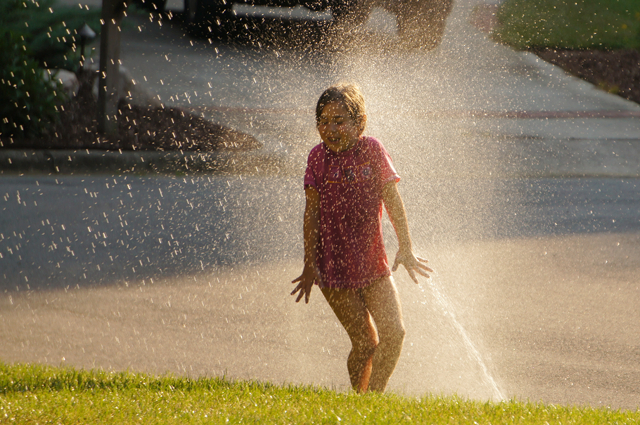
Water Fun
Most kids love playing in the water. So when you need ideas for activities for kids at home, below are some fun ways to add water play into the mix.
Note: Whether your child can do these water activities independently will depend on your child’s age and temperament, so you’ll need to make that decision. If you have things you need to get done, you can always set up a lawn chair nearby your child and catch up on email, read a book, or just take a break!
- Turn on the sprinklers. Tell your child to put on their swimsuit and start the sprinkler in your yard. They can play games like Freeze Tag or London Bridge, design an obstacle course around the sprinkler, or set up a bike wash station to wash their bike with a sponge and soap. Or as another option, get a fun splash mat for your yard.
- Have a water balloon fight. This works best when you have more than one child. Set them up with a bunch of water balloons (get the quick-fill kind here!), and let them loose. They can throw them at each other, or they can play water balloon toss to see how many they can toss to each other before one breaks. If you don’t have water balloons, bust out your squirt guns and fill those up instead.
- Wash the car. Get the kids set up with a bucket, a sponge, soap, and the hose, and let them have at it.
- Set up a water table. This activity is perfect for keeping toddlers and preschoolers busy. You can either get a ready-made water table like this one or make your own using PVC pipe. Here’s the tutorial we used to make ours. When my kids were toddlers and preschoolers, they would happily spend 30 to 45 minutes at the water table!
- Stick them in the bathtub. Bath time can be at any time of day! For younger kids, you definitely will need to supervise, but you can make it special by giving them pool toys, squirt toys, or bubbles to blow while in the bath. For older kids, you can make it a relaxing activity for them by lighting a candle or two, using kid-friendly bubble bath, and turning on some music or their favorite podcast.
Guilt-Free Screen Time
Sticking your child in front of a screen all day typically backfires because then you have to deal with the “screen time zombie effect” later on when they’re finally off screens – which depending on the kid means they’ll be quick to anger, highly irritable, or moody and unmotivated.
So it’s no surprise that both the World Health Organization and the American Academy of Pediatrics recommend limiting daily screen time for kids.
But with that said, all screen time is not created equal.
Research shows that fast-moving animation or video leads to attention issues in children, and those kids get bored by real-life activities more easily. On the other hand, educational and slower-paced screen time doesn’t have the same negative effects.
In other words, a child who played Fortnite for an hour straight will come off screen time a lot crankier than a child who watched a one-hour nature documentary.
“The quality of what children watch on screens is more important than how much they watch.”
Susan Friedman, National Association for the Education of Young Children
In light of the impact different kinds of screen time will have on your child, these screen time activities for kids at home are relatively guilt-free:
- Try Mister Rogers. If your child hasn’t seen the show before, sit down with your child and watch an old Mister Rogers episode, or play LEGOs or make art while the episode plays in the background. Then pay attention to your child. This slow-paced children’s show tends to put many kids in a sort of calm trance, and when the episode is over, they aren’t moody like they tend to be after other kinds of television. Guilt-free screen time? Check!
- Watch a kid-friendly documentary. Here are a few excellent documentaries my kids have enjoyed:
- The Biggest Little Farm – available to rent on Amazon here
- Chasing Coral – available on Netflix here
- The Elephant Queen – available on Apple TV+
- March of the Penguins – available to rent on Amazon here
- A Reindeer’s Journey – available to rent on Amazon here
- Spellbound – available to rent on Amazon here
- Walking with Dinosaurs – available to rent on Amazon here
- Several documentaries from Disneynature have activity packets you can get as a supplement to the documentary
- Watch video adaptations of children’s books. You can purchase these story time videos on Apple TV, or some libraries participate in Kanopy Kids so you can get free access to a whole bucketload of them. After you log into Kanopy and go to the Kanopy Kids section, look for the “Story Time” category. (Side note: You’ll also get access to lots of kid-friendly documentaries through Kanopy!)
- Let a famous actor read aloud to your child. Through Storyline Online, you can access free videos of actors reading children’s books aloud.
- Listen to a children’s book author. Children’s book author Kate Messner put together an amazing resource of videos with authors reading aloud, leading kids through art activities, and more. She’s done the hard work of finding all the awesomeness, so you just need to queue up a few of the videos for your child to watch.
- Go on a virtual safari. If your child loves animals, set them up with a few different live webcams from zoos and aquariums so they can try to find the animals and see what they’re up to. Here are a few of our favorites:
- Beluga whales, penguins, puffins, otters, sea lions, piranhas, and alligators at the Georgia Aquarium
- Lions, elephants, pandas, and naked mole rats at the Smithsonian’s National Zoo
- Giraffes, gorillas, elephants, rhinos, and chimps at the Houston Zoo (you can even control the camera to zoom in and pan around)
- Polar bears, koalas, tigers, baboons, penguins, giraffes, elephants, and more at the San Diego Zoo
- Goats and sheep at the Folly Farm in the United Kingdom (the kids love when they have new babies on the live feed!)
- African animals in the wild in Kenya
- Puppies training to be service dogs
- Let them pick a class. At Outschool, your child can browse the online classes available and pick what they want to learn about, from ASL to raising chickens to video game design – pretty much everything you can think of! Classes are small groups of students who meet via video chat regularly, and teachers are experts on the topic they’re teaching about. For older kids and teens, you can also check MasterClass to see if they have a class with an expert that might be a good fit. For example, they can get tennis lessons from Serena Williams or learn about songwriting from John Legend. If you don’t find a class there, another great option for older kids and teens is Skillshare.
- FaceTime or Skype a relative or friend. For example, if your child’s grandparents are retired, set your child up so they can make a video call and chat. The grandparents will be happy, and your child will be entertained. Face-to-face video calls can have positive effects on kids, so the WHO and AAP say they’re appropriate even for toddlers!
- Do yoga. Screen time can be a useful way to keep your child active, especially on rainy days. For kids ages 3 to 6, we enjoyed this yoga video for kids. For kids ages 7 to 12, this yoga video is a great fit. For older kids, we love Jillian Michaels’s Yoga Meltdown.
- Play a brain food app or game. When it comes to apps and games, some are better than others for staving off the screen time zombie effect. Here’s a list of the best educational apps for kids that won’t make them moody and unruly afterwards.
Tip: If your child wants to play a fast-moving app or game, set a timer or an app time limit to keep the amount of time reasonable and minimize the negative effects. For example, on iOS devices, you can use the Screen Time settings to configure a time limit for specific apps.
4 Hidden Reasons Why Your Kid Gets Bored Easily
If your child tends to get bored easily and can’t seem to stick to any activities you line up for them, you might need to address one or more underlying factors. Because if you don’t address those underlying factors first, a list of activities for kids at home won’t ultimately help you keep your child busy and entertained. They’ll lose interest fast and boomerang right back to you.
Below, you’ll find the most common reasons why your child might be quick to boredom, plus suggested simple fixes you can start right away.
1. Share the Power
If you’re the one who decides which activity your child will do next, your child might be experiencing what child development experts call a lack of “agency” when it comes to playtime.
“[A] critical requirement for learning through play is that children must experience agency and be supported rather than directed…Agency in learning through play means seeing the child as capable rather than a blank slate to be filled…Agency is about the balance of initiative in the child-adult relationship: are children’s interests listened to? Are they consulted on decisions that concern them? Do they initiate an activity and invite adults to join them in play and decision-making? In other words, what opportunities do children have for exerting their thinking and actions in a social context where others hold the same rights?
Researchers find that this kind of scenario, where caregivers ensure that children play an active role in solving a problem-solving task, promotes children’s executive functions – that crucial suite of skills used in goal- setting and flexible thinking.”
Learning Through Play: A Review of the Evidence
Translation? Your child needs to have a say in how they’ll be spending their playtime. Not only will they be more likely to stick with an activity they had a hand in choosing, you’ll strengthen their brain in a way that will increase their ability to focus and stick to something:
“[Kids] who plan their own time, set weekly goals, and evaluate their own work build up their prefrontal cortex and other parts of the brain that help them exert greater cognitive control over their lives. These so-called executive skills aid children with self-discipline, avoiding distractions, and weighing the pros and cons of their choices.”
The Secrets of Happy Families
If you tend to pick the activity and then tell your child what they’re going to do, that can lead to your child losing interest in the activity quickly.
How to Fix It: The next time you want to set your child up with an activity, first ask them what they want to do. If they draw a blank, at the end of this post, you can get the free printable list of activities for kids at home and share it with your child. If they still aren’t sure, you can play what we call the Third Time’s a Charm Game, where you keep giving different options until your child has picked the same activity three times. Here’s a quick example:
- Parent: Which sounds better, playing inside or outside? (This first question just helps direct you towards which activities to start with when giving options to your child.)
- Child: Inside
- Parent: Which sounds better, playing a game or making art?
- Child: Hmm…I think making art
- Parent: Which sounds better, making art or reading?
- Child: Making art
- Parent: Which sounds better, making art or listening to a podcast?
- Child: Making art!
Or as an alternative, you can play the Pick 3 Game, where you give your child a list of activities to choose from, then have them rank their top three choices #1 through 3. That has the added benefit of giving them a backup option to move to next if the first option doesn’t work out for some reason.
2. Fill That Tank
Connection breeds cooperation. In other words, when your kids feel a strong connection with you, they’ll be more likely to cooperate.
On the other hand, when your child feels a lack of connection, that leads to more unnecessary power struggles and less cooperation from your child when you ask them to do something, like when you need them to entertain themselves so you can focus on work or household chores.
One of the best ways to make sure your child will stay engaged in an activity is to make sure their connection “tank” is full first. That way, they won’t interrupt their own play to seek you out for a dose of meaningful connection.
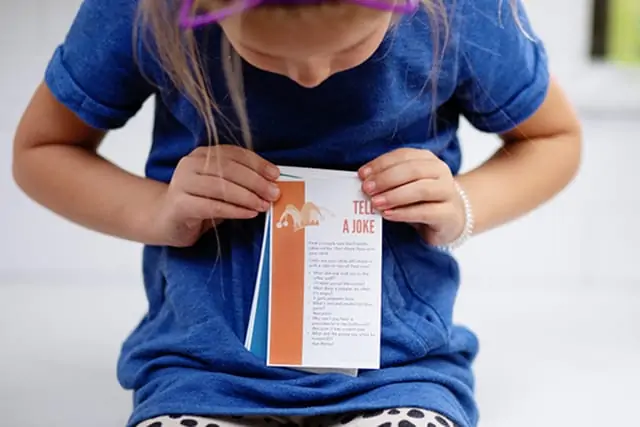
How to Fix It: Before you set your child up with an activity to do independently (see strategy #3 below), spend 5 or 10 minutes connecting with them.
Here’s a quick list of a few of the best (and quickest!) ways to connect with your child every day. Tip: For a handy way to remember to do this every day, you can get my Family Connection Cards here. In just 10 minutes a day, these powerful cards will make your child feel absolutely loved and stop the power struggles and interruptions caused by disconnection.
- Give your child a hug. But make sure it’s a good quality hug of six seconds or more. Here’s why. If your child isn’t used to you dishing out impromptu hugs, try a high-five instead and work up to hugs.
- Read a book. Your child is never too old to be read to. For older kids, you may find it fun to take turns reading aloud from the same book. If you don’t currently read aloud to your child regularly, be sure to check out the super helpful tips in this post: Want to Raise Smart, Kind Kids? Science Says Do This Every Day.
- Sit down and just play for a few minutes. No smartphones, no multitasking – follow your child’s lead.
- Go outside together. Take a walk, play catch, or hop on your bikes for a quick ride around the block.
- Get quiet. Start the day with a kid-friendly meditation using an app like Headspace. Meditation helps calm anxious feelings and increases your attention span and ability to focus. And that’s something both you and your child can benefit from!
- Play a board game or card game. We’ve found that Sleeping Queens is the perfect quick game for a wide range of ages, but for more ideas check out our full list of the absolute best family games for all ages. We’ve spent countless hours testing different family games with all different ages to find the cream of the crop!
Bonus: All game orders placed in our family-owned shop get a $7.99 bonus credit after purchase to spend on instant downloads!
Sleeping Queens
“My daughter and I love Sleeping Queens! It teaches them math without them even realizing it – or me, for that matter. I remember my daughter laid down a sequence that was like 1 + 3 + 5 = 9, and I thought ‘How did you know that…?’ Then I realized she just figured it out from doing math in the game. So cool to watch her learn right before my eyes.” – Ann
3. Set the Bar Higher
On a typical school day and even on many weekend days, nearly every hour of our kids’ days is spoken for, filled with scheduled and structured activities. Between school, extracurricular activities, sports events, play dates, birthday parties, family get-togethers, and more, that doesn’t leave much downtime for kids to engage in what child development experts call “unstructured free play.”
And yet, unstructured play is essential to childhood development:
“Unstructured play is a set of activities that children dream up on their own without adult intervention. This type of play rarely has predetermined goals or objectives but instead allows children to create their own rules and establish their own limits. Recent research suggests that children should experience twice as much unstructured time as structured play experiences and touts the benefits of unstructured play on whole child development…
It develops self-determination, self-esteem, and the ability to self-regulate – all vital elements of emotional development. It fosters social competence, respect for rules, self-discipline, aggression control, problem solving skills, leadership development, conflict resolution, and playing by the rules…It provides fertile ground to cultivate creativity and imagination…[And] it sees boredom as a vehicle for children to create their own happiness, enhance inventiveness, and develop self-reliance.”
The Decline of Unstructured Play
But in today’s world, kids have gotten used to the adults in their lives directing their play and telling them how to spend their time. When it comes to figuring out how to spend unstructured free time, kids haven’t had much practice. So when we suddenly expect them to go play independently so that we can focus on something we need to get done, kids aren’t sure what to do with themselves.
For example, suppose that between you and your spouse, you were the one who always did the grocery shopping, but suddenly one day you asked your spouse to do it because you were busy. They might head to the grocery store and get there, only to realize they didn’t know what to do. So they might end up texting you every couple minutes to ask questions. But if instead, you asked your spouse to take over the weekly grocery shopping from here forward, that would change their approach. That first time, they might need a lot of guidance from you. But with clearer expectations, people tend to shift their mindset and approach it as a learning opportunity so that they can be more independent the next time.
How to Fix It: Clearly set the expectation for your child by establishing a routine of free play every day, to start either at a specific time of day or after another activity like after lunchtime. It can help to come up with a special name for this time of day, like “Quiet Time” or “Free Play Hour.” In my family, we call this time “Choose Your Own Adventure.”
Here’s one way you can make this routine work for your family:
- Brainstorm. Before you’re scheduled to start, at the end of this post, get the free printable list of activities for kids at home and look through the list with your child.
- Pick something. Ask your child to articulate what they’ll be doing during “Choose Your Own Adventure” time. If they have trouble deciding, try the Third Time’s a Charm Game or Pick 3 Game from strategy #1 above. (Side note: They’ll be much more likely to stick with it if they set their intention ahead of time for what they plan to do!)
- Set it up. Help your child get everything they need set up so that they can do what they’ve picked without needing to come to you.
- Start a timer. Set a timer to communicate to your child that you expect them to entertain themselves and to show when you’ll be joining them again. Even young kids can understand the concept of a timer counting down. You can use a kitchen timer, set a timer on your oven or microwave, or set up a tablet or other mobile device in a visible spot with the screen locked on a timer.
- For younger kids, you might start with a short period of time like 10 or 15 minutes.
- For older kids, you might start with 30 minutes and work up to a longer chunk of time.
- Skedaddle. Let your child know you’ll be looking forward to hearing how it goes, then go do whatever you need to do, whether that’s working from home, catching up on housework, or just relaxing in the bath with a good book.
Related: Working From Home With Kids? Here’s the Best Advice for Parents {Printable}

4. Wipe the Slate Clean
Research shows that when kids are surrounded by toys, they typically find it harder to concentrate on any one thing.
They end up jumping around from toy to toy without ever getting fully engrossed in playing with one specific thing. But it’s the experience of being engrossed in one toy that leads to real growth and development for your child.
It’s kind of like if you started 10 different books all at once and took turns reading a couple pages from each one. You’d never get fully immersed in any of the books, and you’d struggle to pull any significant life lessons or new knowledge from the reading.
And the clincher that brought this home for me? I discovered that the average 10-year-old owns 238 toys but plays with just 12 on a daily basis. Whoa.
If your child struggles to stay engaged in any one activity, it might be that their surrounding toys are distracting them and keeping them from being able to focus.
How to Fix It: Consider setting up a simple toy rotation system so that your child can engage in deep, focused play. That will prevent them from bouncing between several things without ever fully engaging and also prevent the “boomerang” effect of them losing interest quickly and coming right back to you.
For a detailed guide on how to set up a super simple toy rotation system for your family, check out Toy Rotation: How to Make Your Kids Love It + Free Printables.
Get Your Free Printable: The Best Activities for Kids at Home
Use these free printable cards to get ideas of activities for kids at home.
- Get the free printable. Join my weekly-ish newsletter and as a bonus, you’ll get the printable! Just click here to get it and subscribe.
- Print. Any paper will do the trick, but card stock would be nice and sturdy.
- Cut. Or if you’re like me and you can’t cut a straight line to save your life, fold and tear to get a charmingly casual look.
- Pop the cards into an empty bowl or mason jar and put it on your dining room table or kitchen counter. Then when your kid says “I’m bored,” they can pick a random card and do it. Easy peasy!
For more ideas on how to best share this list with your child, check out the 4 Hidden Reasons Why Your Kid Gets Bored Easily section above.
Here’s a sneak peek of your free printable list of activities for kids at home:
Before you go, get my FREE cheat sheet: 75 Positive Phrases Every Child Needs to Hear
Your Turn
What are the best activities for kids at home you’ve tried? Share in a comment below!

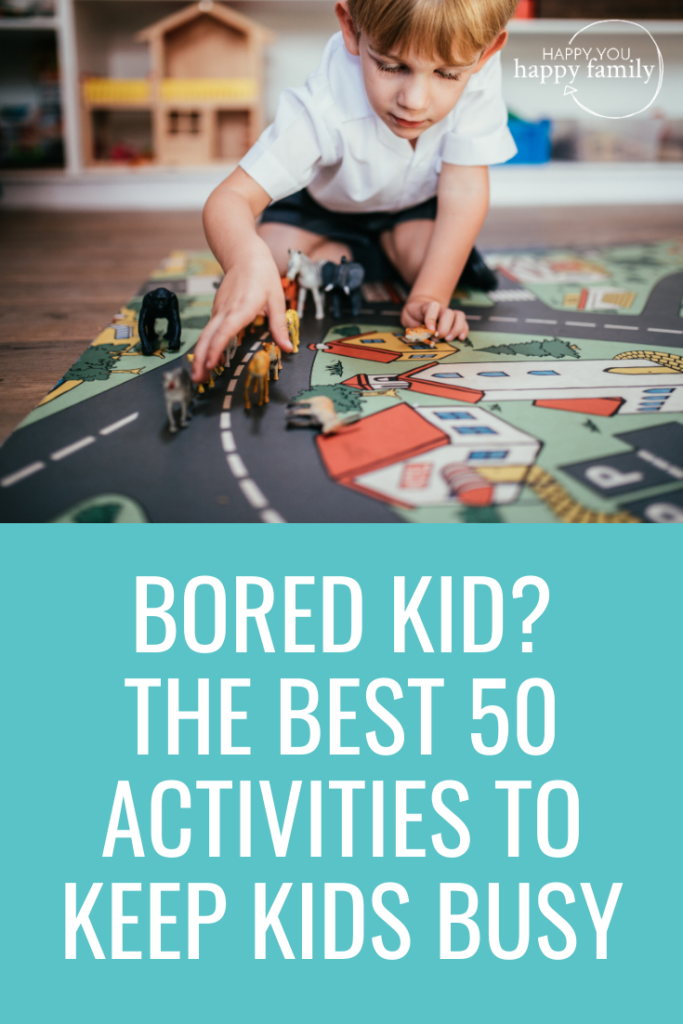
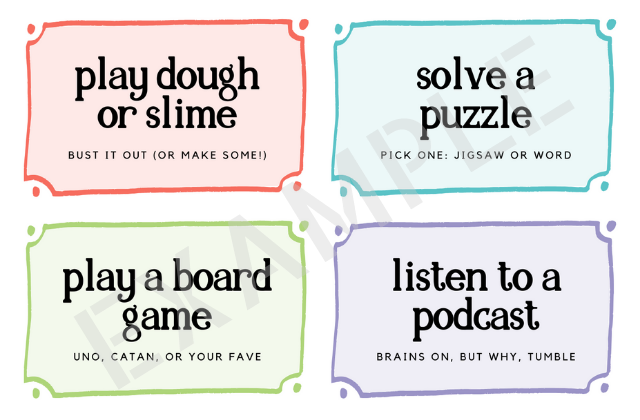
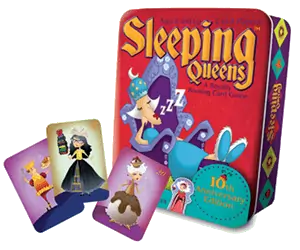

Note: All information on this site is for educational purposes only. Happy You, Happy Family does not provide medical advice. If you suspect medical problems or need professional advice, please consult a physician.